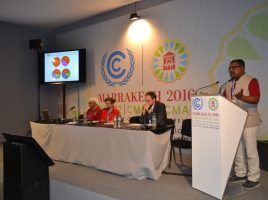Understanding a Resilient World
Resilience simply put is the way we deal with change. More specifically, it is the capacity of any system to face changing circumstances and still continue to maintain its functions, structure, and identity.[i] It describes the degree to which the system is capable of self-organisation, learning, and adaptation. With the rise of crisis, shocks and disruption together with rapid urbanisation further concentrating these risks, building resilience has come to play a pivotal role in development especially urban. Within the resilience theory, humans and nature are considered as strongly co-related and interdependent and therefore are taken as one social-ecological system. Linked with systems thinking, these social-ecological systems are considered to be complex systems that cannot be predicted and are usually non-linear with feedback loops over time and space. [ii]
and adaptation. With the rise of crisis, shocks and disruption together with rapid urbanisation further concentrating these risks, building resilience has come to play a pivotal role in development especially urban. Within the resilience theory, humans and nature are considered as strongly co-related and interdependent and therefore are taken as one social-ecological system. Linked with systems thinking, these social-ecological systems are considered to be complex systems that cannot be predicted and are usually non-linear with feedback loops over time and space. [ii]
Promoting resilience means encouraging cross-dialogue amongst different fields of social sciences, science, politics, and environment – thereby challenging the nature of decision-making and forcing our focus on fairness, knowledge building, and developing capacities.[iii] Such co-evolution can allow the entire system to exploit “shocks and disturbances like a financial crisis or climate change to spur renewal and innovative thinking.”[iv] In this sense, applying resilience thinking to a city/urban area enables it to become “better for both the short and long-term, for everyone.”[v] However, current urban resilience planning and management efforts may be leading us to unsustainable paths.
Resilience building needs to be complementary to developing sustainability. One of the objectives of sustainable development is to maintain well-functioning social, economic and ecological systems and it is in this need for persistence/maintenance that we find our link between resilience and sustainability.[vi] However, for far too long now, resilience thinking has concentrated only on ways to adapt/cope – a narrow perspective aiming solely at returning to the original stable state. Adopting such a “bouncing back” outlook can potentially lock us into the “old and unsustainable urban patterns.”[vii] By relying on the use of hard and soft implementation mechanisms, it thwarts any potential transformation much needed for creating sustainable systems.[viii]
There are three approaches towards building resilience:[x]
1)Recovery: Quick short-term effort to bounce back.
2)Adaptation: Medium-term strategy to adjust to the changes but remaining essentially within the older system. However, this strategy can sometimes overlap with the next one.
3)Transformation: A more long-term perspective enabling a deep and fundamental change of the entire system.
While these three strategies may co-exist there is the danger of conflicts as well. Hence, resilience building is not only about its benefits but also acknowledging the possible trade-offs that need to be prioritised in its thinking and managed when applied in practice – something currently lacking in both the spheres.[xi] For example, how can you create and build resilience through development of local economy and community while also meeting the needs of a rapidly growing city in a highly globalised world? Furthermore, this highly complex and multi-layered concept, needs to clearly define resilient of what, to what, and especially, for whom?
We can begin the process by making use of the seven principles for building a resilient world: [xii]
1)Maintain diversity and redundancy: More diversity implies more resilience as there are more ways to adjust to changes, whereas redundancy allows some components in the system to compensate of for the loss or failure of others.
2)Manage connectivity: Better connectivity enables a quicker recovery from shocks and disturbances. However, it may also increase the risk of exposure to the same.
3)Manage slow variables and feedbacks: It is important for the entire system to be well maintained so that there is continuity in the provisions of essential ecosystem services.
4)Foster complex adaptive systems thinking: There is an urgent need to understand the close inter-linkages that exist between different actors and systems within the social-ecological system to encourage building of resilience and minimising trade-offs.
5)Encourage learning: Non-linear and unpredictability of systems thinking requires constant revision and adaptation to strategies and approaches necessitating building more and more knowledge and learning.
6)Broaden participation: Involving all the stakeholders help in creating a shared understanding and legitimacy.
7)Promote polycentric governance systems: It helps in binding and implementing all above six principles and ensuring right action at the right time.
As Yukimoto Ito (Sendai Vice Mayor) has said “There is no finish line. Resilience is an ongoing process.” We can at least make sure that we now enter the process with the correct tools and understanding while continuously re-evaluating the same!
Mandira Thakur
mandirathakur@gmail.com
References
[i] Holling, C. S., 1973, “Resilience and stability of ecological systems”
[ii] Walker and Salt, 2006, “Resilience Thinking. Sustaining ecosystems and people in a changing world”
[iii] Olazabal et al., 2012, “Why Urban Resilience?”
[iv] www.stockholmresilience.org/21/research/research-news/2-19-2015-what-is-resilience.html
[v] www.100resilientcities.org/resilience#/-_/
[vi] Pisano U., 2012, “Resilience and Sustainable Development: Theory of resilience, systems thinking and adaptive governance”
[vii] Chelleri, L, et al., 2015, “Resilience trade-offs: addressing multiple scales and temporal aspects of urban resilience”
[viii] ibid
[ix] ibid
[x] ibid
[xi] Chelleri, L., 2016, “ City Resilience?”
[xii] Biggs et al, 2105, “Principles for Building Resilience: Sustaining Ecosystem Services in Social-Ecological Systems”, Cambridge




Leave a Reply